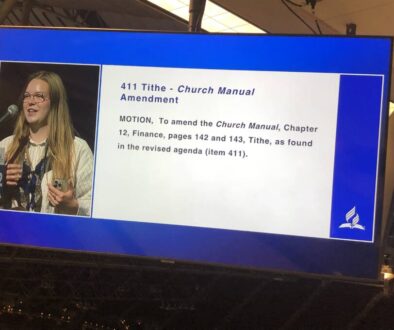Details of Plan to Restructure Adventist Publishing Houses Emerge
by Monte Sahlin
By Adventist Today News Team, May 9, 2014
Update added May 14
A restructuring proposal for the two Seventh-day Adventist publishing houses that are under the direct supervision of the denomination's General Conference (GC) has been distributed to members of its governing body, the GC executive committee. Adventist Today has obtained a copy of the six-page document which envisions the Review & Herald Publishing Association (R&H) becoming an office at the GC complex in Silver Spring, Maryland, and the Pacific Press becoming an institution of the denomination's North American Division (NAD).
R&H facilities and equipment in Hagerstown, Maryland, would be sold and its employees transferred to Pacific Press or laid off. The intellectual property of R&H and the periodicals that it publishes for the GC would be transferred to an office within the GC staff in Silver Spring where it is anticipated that little or no additional personnel are needed because the GC already employs the editorial staff for these products.
Pacific Press will provide the production and distribution activities for R&H so long as it can provide these services at an acceptable cost. As an NAD institution, it will have the central role for the Adventist publishing ministry in the United States, Canada and related island nations.
R&H "will no longer operate a printing/production facility," the plan states. The R&H office will be "moved from Hagerstown … to the General Conference office" and "will require minimal staffing, if any" beyond the editors who "are already employees of the General Conference." R&H "will function as the publisher for current General Conference publications and as the publisher for designated new products originating from the General Conference and intended for global use."
"Publications and production functions" of R&H "that primarily serve the North American Division … will become the responsibility of the North American Division and its publishing house," the document states. Pacific Press "becomes an institution of the North American Division" under the plan and "continues to function from Nampa, Idaho." It will accept responsibility "for the printing/production and fulfillment services required by both the North American Division and the General Conference," including "the publishing house activities" that R&H "performs for the North American Division."
The plan anticipates that once it is voted by the GC executive committee it will be recommended to the two boards of the institutions and these groups will also endorse it and send it to their respective constituency meetings for final approval. It also instructs that the charters and bylaws for the two institutions be revised to constitute new constituencies and boards.
In addition to a summary of the need for this restructuring plan, the document anticipates arguments against the plan, especially those based on quotations from Ellen G. White, the denomination's cofounder believed to have exercised a prophetic role during its founding and developmental periods. It describes the vast changes in publish technology, reading patterns, marketing methods and economic realities since R&H was formed in 1861 and Pacific Press in 1875. It traces developments since 1980 when Southern Publishing Association was merged with R&H, listing in a footnote five major assessments of the situation completed from 1991 through 2013.
"Within the last 25 years [these] studies have all recognized that in due course it would be expedient for the North American Division to have a greater oversight role in the publishing activities serving its territory," the document notes. It views the new plan as essentially left-over business from the decision in the mid-1980s to organize the NAD as a separate entity from the GC.
Perhaps anticipating that some will argue that White stated that a plan such as this should not be implemented, the document points out that today the denomination has 62 publishing houses around the world and at the time she wrote there were only two. "Many of her messages … came during a period marked by tensions between the two. Less than cordial relations prevailed" and White "gave pointed messages about the danger of centralizing control of the denomination's publishing work in one institution." It also lists significant restructuring of these two publishing houses in 1903, 1904 and 1980.
The document cites three principles that summarize White's views. (1) "Large institutional concentrations in one locale are not the best way for the Church to fulfill its mission. … (2) No single individual or small group of individuals should have sole determination of the content or expression of denominational beliefs and teachings. … (3) Ellen G. White recognized a fundamental hermeneutical principle in the use of her writings. 'Regarding the testimonies, nothing is ignored; nothing is cast aside; but time and place must be considered.' [Selected Messages, Vol 1, Chapt 4] Changed circumstances call for 'common sense' application of principles."
It remains to be seen how the plan will be received by denominational administrators. Many of the people who will vote on whether or not to adopt this plan (or amend it) have a stake in maintaining the status quo no matter how desperate the financial realities have become. In the summer of 2013 an effort to develop a similar plan quickly came to an end, as Adventist Today has previously reported.
Update
On Monday (May 12) the boards of R&H and Pacific Press met separately and both voted to approve the reorganization plan and recommend it to their constituency groups. Two separate constituency meetings will convene on June 17, both at the GC office in Silver Spring, Maryland. If approval is given by both groups, the new structure will begin to be implemented on July 1.
Opposition to the restructuring plan is being organized by some retired employees of R&H. The Hagerstown Herald-Mail reported that a meeting was held last Thursday evening (May 8) at the local Adventist church. It was addressed by Harold "Bud" Otis, who was the president of R&H when it moved to the town in the early 1980s and supervised the construction of the facilities. He "expressed heartache" about the planned changes and revealed that the floor had been installed during the original construction to expand the plant to twice its current capacity.
The R&H factory "needs to stay until the Lord comes," the newspaper quoted Otis as saying to the 70 people present. He shared plans for an independent review of the decision to reorganize and told the group that the Columbia Union Conference had agreed to pay for a study to examine the viability of the R&H continuing to operate as it has in the past. The newspaper also reported that the Chamber of Commerce in Hagerstown and local government officials have been approached to support keeping the printing plant in operation.



